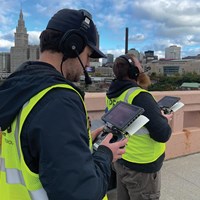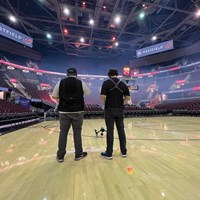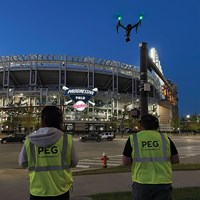Benefits of a Dual-Operator Drone
We often talk about our high-end DJI Inspire 2 drone and we mention that it is a dual-operator drone, but what does that mean? What are the advantages of a drone like this and why would it benefit your shoot?
Let's break it down.
What is a dual-operator drone?



What is a dual-operator drone? A dual-operator drone is one that can be controlled by two people, but likely not in the way that you are thinking. Each person does not have control over the flight systems of the drone, rather responsibilities are split between two controllers and operators.
One drone operator is the pilot, this person is in control of the drones flight and their controller is fully dedicated to that job. The other operator has full control of the camera moves and the gimbal on the drone and handles every task not related to the flight of the aircraft.
How is it different?
I want to briefly touch on why this is so important by comparing it to other drones that are easier to access on the market.
The only lower-price drone that DJI offers with this technology is the new Mavic 3, and this does not offer nearly the quality that the Inspire 2 does when it comes to video and post production.
The other lower-end drones are all single operator which means in order for them to be able to focus on the shot they are getting, they almost always need to use a waypoint smart function to handle the flight of the drone. This means much more set up time for each shot as they need to first program the waypoints, and then run the flight automatically while controlling the camera to get the shot.
With dual operator drones there is no need to run a waypoint path as we can maintain constant control of the drones flight path and full control of the camera every time, right from the start.
Why is it better?
Better Use of Battery
First, a dual operator setup is a lot more battery efficient, because we don't need to spend that time mapping out waypoints. When we want to execute a move, we communicate it and execute it. This gives us more flight time spent shooting and less time spent setting up, maximizing the amount of useable footage we can get while in the air.
Target Tracking
Another huge advantage is tracking moving targets while tailing them, for instance a helicopter flying ahead of you in the sky. On a single operator drone this would be very hard, they would likely choose to control flight for safety and the ability to adapt to the vehicle. By choosing to control the flight, they now must use another smart function of the drone to automatically track the helicopter. This may work, but the smart tracking on drones is not always clean, and doesn’t account for any framing choices you may want to make, it just keeps a subject in frame to the best of its ability. We are able to constantly make purposeful adjustments to both flight path and framing simultaneously, which is always going to provide a higher-end shot.
Flight Safety
In my previous comparison, I mentioned safety, and that is another huge benefit of a dual operator drone. There are many times where, for the sake of safety, you need to be in full control of the flight of the drone. With single operator drones this limits you in each of those scenarios to relying on a tracking feature or simply not moving the camera at all. In the long run your shots will feel much less dynamic in situations where safety is a concern, whereas a dual operator drone allows safety to be front of mind at all times. We even take it a step further for safety and employ a Visual Observer to call out any possible hazards during our flights.
Best Person for the Job
The last major benefit of this system is that we are able to pair the best pilot with the best camera operator for each situation, ensuring that both tasks are handled as well as possible. A single operator setup someone may be a fantastic pilot, but not have an eye for creative shots, or vice-versa.
Our dual-operator setup truly allows us to be as efficient and safe as possible – while capturing the absolute best shots on every drone flight.




